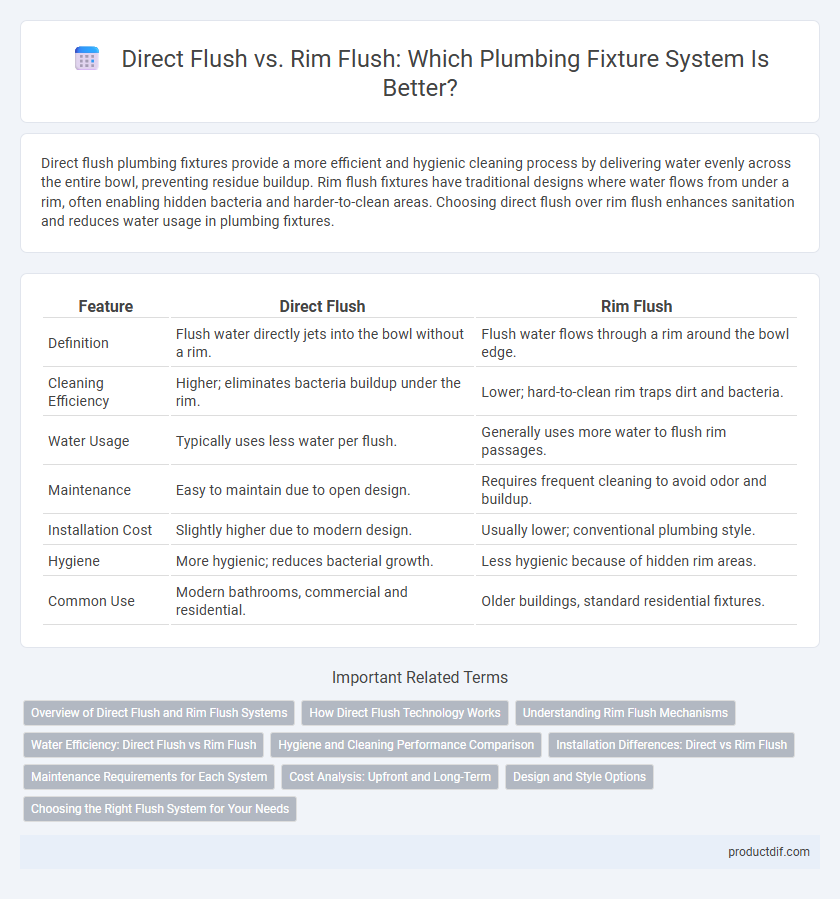Direct flush plumbing fixtures provide a more efficient and hygienic cleaning process by delivering water evenly across the entire bowl, preventing residue buildup. Rim flush fixtures have traditional designs where water flows from under a rim, often enabling hidden bacteria and harder-to-clean areas. Choosing direct flush over rim flush enhances sanitation and reduces water usage in plumbing fixtures.
Table of Comparison
| Feature | Direct Flush | Rim Flush |
|---|---|---|
| Definition | Flush water directly jets into the bowl without a rim. | Flush water flows through a rim around the bowl edge. |
| Cleaning Efficiency | Higher; eliminates bacteria buildup under the rim. | Lower; hard-to-clean rim traps dirt and bacteria. |
| Water Usage | Typically uses less water per flush. | Generally uses more water to flush rim passages. |
| Maintenance | Easy to maintain due to open design. | Requires frequent cleaning to avoid odor and buildup. |
| Installation Cost | Slightly higher due to modern design. | Usually lower; conventional plumbing style. |
| Hygiene | More hygienic; reduces bacterial growth. | Less hygienic because of hidden rim areas. |
| Common Use | Modern bathrooms, commercial and residential. | Older buildings, standard residential fixtures. |
Overview of Direct Flush and Rim Flush Systems
Direct flush systems deliver water directly to the toilet bowl for efficient cleaning and reduced water usage, enhancing hygiene and minimizing splash. Rim flush systems channel water through a rim with holes, allowing water to flow around the bowl's edge, effectively rinsing the surface but often using more water. Both systems are designed to optimize flushing performance, with direct flush offering a more modern, water-saving solution and rim flush providing thorough coverage around the bowl.
How Direct Flush Technology Works
Direct flush technology uses a powerful, targeted jet of water that flows directly into the toilet bowl, effectively eliminating waste and reducing water usage compared to traditional rim flush systems. By delivering water from multiple nozzles around the bowl's perimeter, this method ensures a more thorough and hygienic cleaning without relying on a rim, which can harbor bacteria. The efficient design minimizes splash and noise while offering easier maintenance and enhanced durability in modern plumbing fixtures.
Understanding Rim Flush Mechanisms
Rim flush mechanisms in plumbing fixtures direct water flow around the toilet bowl's rim for effective cleaning and reduced splashing. These systems use strategically placed outlets to ensure even water distribution, enhancing hygiene by eliminating hidden bacteria traps common in traditional designs. Understanding rim flush technology highlights its efficiency in water conservation while maintaining powerful cleaning performance compared to direct flush models.
Water Efficiency: Direct Flush vs Rim Flush
Direct flush toilets utilize a concentrated water stream that efficiently removes waste with less water compared to rim flush models, reducing overall water consumption. Rim flush toilets distribute water around the bowl's rim, often requiring more water to achieve thorough cleaning, leading to increased water usage. Choosing direct flush technology supports water-saving initiatives by minimizing water waste while maintaining effective flushing performance.
Hygiene and Cleaning Performance Comparison
Direct flush toilets provide superior hygiene and cleaning performance by allowing water to flow directly into the bowl, effectively removing waste and reducing bacterial buildup. Rim flush toilets feature an indirect water flow beneath the rim, which can trap debris and bacteria, making them harder to clean thoroughly. Enhanced water distribution in direct flush designs leads to improved sanitation and easier maintenance, making them a preferred choice for hygiene-conscious environments.
Installation Differences: Direct vs Rim Flush
Direct flush toilets feature a streamlined installation process that integrates the flushing mechanism directly into the bowl, reducing the need for additional components and making it easier to clean. Rim flush toilets require installing a rim with multiple water outlets around the bowl edge, which involves more complex plumbing connections and increased maintenance. Choosing direct flush systems minimizes installation time and enhances hygiene through simpler design.
Maintenance Requirements for Each System
Direct flush plumbing fixtures require less frequent cleaning due to their streamlined design, which minimizes residue buildup and reduces bacterial growth. Rim flush systems often demand more intensive maintenance as trapped debris under the rim can lead to odors and blockages, necessitating regular scrubbing and inspection. Efficient maintenance of direct flush models can extend fixture lifespan and improve hygiene in commercial and residential settings.
Cost Analysis: Upfront and Long-Term
Direct flush toilets generally have a higher upfront cost due to advanced engineering and efficient water usage technology, but they offer significant savings on water bills over time. Rim flush models are typically cheaper initially but tend to use more water, leading to increased operational expenses and potential maintenance costs from residue buildup. Evaluating lifetime cost-effectiveness, direct flush fixtures provide better return on investment through reduced utility bills and lower cleaning requirements.
Design and Style Options
Direct flush toilets feature a sleek, rimless design that enhances modern aesthetics and simplifies cleaning by eliminating hidden areas where dirt and bacteria can accumulate. Rim flush toilets incorporate a traditional rim around the bowl, offering a timeless look with varied style options and allowing customizable water flow patterns for effective cleaning. Both designs provide diverse material finishes and shapes, catering to different bathroom decor preferences and functional needs.
Choosing the Right Flush System for Your Needs
Selecting the appropriate flush system depends on water efficiency, hygiene, and maintenance preferences. Direct flush toilets utilize powerful jets to clean the bowl thoroughly without a rim, reducing bacteria buildup and simplifying cleaning. Rim flush models offer traditional water distribution around the bowl edge, providing consistent flushing performance with familiar design and ease of installation.
Direct flush vs Rim flush Infographic

 productdif.com
productdif.com